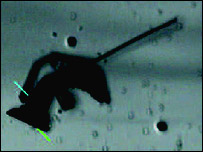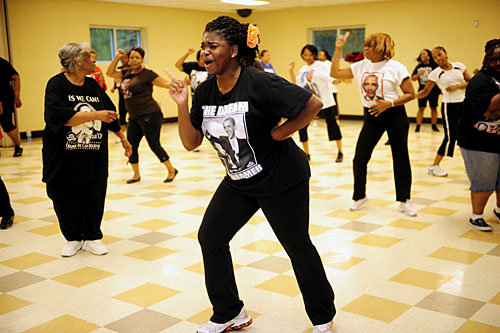 The robot is a dramatic example of the marriage of biotechnology with nanotechnology
The robot is a dramatic example of the marriage of biotechnology with nanotechnology
Tiny robots powered by living muscle have been created by scientists at the University of California, Los Angeles.
The devices were formed by “growing” rat cells on microscopic silicon chips, the researchers report in the journal Nature Materials.
Less than a millimetre long, the miniscule robots can move themselves without any external source of power.
The work is a dramatic example of the marriage of biotechnology with the tiny world of nanotechnology.
In nanotechnology, researchers often turn to the natural world for inspiration.
But Professor Carlo Montemagno, of the University of California, Los Angeles, turns to nature not for ideas, but for actual starting materials.
In the past he has made rotary nano-motors out of genetically engineered proteins. Now he has grown muscle tissue onto tiny robotic skeletons.
Living device
Montemano’s team used rat heart cells to create a tiny device that moves on its own when the cells contract. A second device looks like a minute pair of frog legs.
“The bones that we’re using are either a plastic or they’re silicon based,” he said. “So we make these really fine structures that mechanically have hinges that allow them to move and bend.
“And then by nano-scale manipulation of the surface chemistry, the muscle cells get the cues to say, ‘Oh! I want to attach at this point and not to attach at another point’. And so the cells assemble, then they undergo a change, so that they actually form a muscle.
“Now you have a device that has a skeleton and muscles on it to allow it to move.”
Under a microscope, you can see the tiny, two-footed “bio-bots” crawl around.
Professor Montemagno says muscles like these could be used in a host of microscopic devices – even to drive miniature electrical generators to power computer chips.
But when biological cells become attached to silicon – are they alive?
“They’re absolutely alive,” Professor Montemagno told BBC News. “I mean the cells actually grow, multiply and assemble – they form the structure themselves. So the device is alive.”
The notion is likely to disturb many who already have concerns about nanotechnology.
But for Carlo Montemagno, a professor of engineering, it makes sense to match the solutions that nature has already found through billions of years of evolution to the newest challenges in technology.
 Myth: In ten years there will be no bananas left
Myth: In ten years there will be no bananas left



